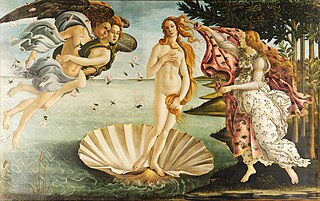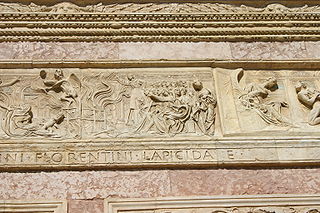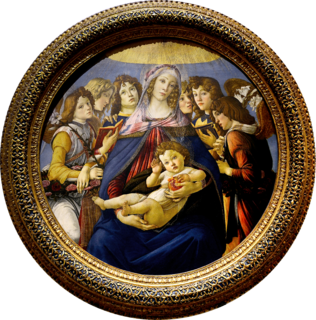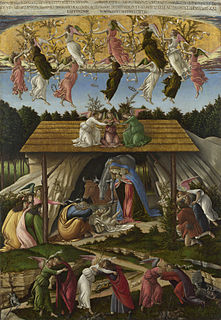
Alessandro di Mariano di Vanni Filipepi, known as Sandro Botticelli, was an Italian painter of the Early Renaissance. Botticelli's posthumous reputation suffered until the late 19th century, when he was rediscovered by the Pre-Raphaelites who stimulated a reappraisal of his work. Since then, his paintings have been seen to represent the linear grace of Early Renaissance painting.

The Birth of Venus is a painting by the Italian artist Sandro Botticelli, probably made in the mid 1480s. It depicts the goddess Venus arriving at the shore after her birth, when she had emerged from the sea fully-grown. The painting is in the Uffizi Gallery in Florence, Italy.

A bonfire of the vanities is a burning of objects condemned by authorities as occasions of sin. The phrase usually refers to the bonfire of 7 February 1497, when supporters of Dominican friar Girolamo Savonarola collected and burned thousands of objects such as cosmetics, art, and books in Florence, Italy on the Shrove Tuesday festival.
Seyfert is a surname, and may refer to:

Pallas and the Centaur is a painting by the Italian Renaissance painter Sandro Botticelli, c. 1482. It is now in the Uffizi Gallery in Florence. It has been proposed as a companion piece to his Primavera, though it is a different shape. The medium used is tempera paints on canvas and its size is 207 x 148 cm. The painting has been retouched in many places, and these retouchings have faded.

The Madonna of the Pomegranate was painted in circa 1487 with tempera on a wood panel by Sandro Botticelli. Sandro Botticelli is a well known Italian Renaissance artist from Florence, Italy. The use of the circular format, better known as a tondo, focuses the attention on the main characters, the Virgin Marry and baby Jesus, who are surround symmetrically by angels on each side. Botticelli's use of tempera grassa give the characters a real look, better known as a "naturalistic" style, which is common during the Renaissance. The Virgin Mary is holding baby Jesus gently in her arms while holding a pomegranate in her left hand. The pomegranate being displayed has a few different interpretations of its meaning in the religious piece. There are many replicas of the Madonna of the Pomegranate due to artists during the Renaissance would copy other established artists' artwork to master their own skills. The painting is currently on display at the Uffizi Gallery in Florence, Italy.

Simonetta Vespucci, nicknamed la bella Simonetta, was an Italian noblewoman from Genoa, the wife of Marco Vespucci of Florence and the cousin-in-law of Amerigo Vespucci. She was known as the greatest beauty of her age in Italy, and was allegedly the model for many paintings by Sandro Botticelli, Piero di Cosimo, and other Florentine painters. Some art historians have taken issue with these attributions, which the Victorian critic John Ruskin has been blamed for promulgating.

Madonna in Glory with Seraphim is a painting by the Italian Renaissance painter Sandro Botticelli, executed c. 1469–1470. It is housed in Galleria degli Uffizi, Florence.

The Mystical Nativity is a painting dated c. 1500–1501 by the Italian Renaissance master Sandro Botticelli, in the National Gallery in London. Botticelli built up the image using oil on canvas. It is his only signed work and has an unusual iconography for a painting of the Nativity.
Sandro is an Italian, Portuguese, Spanish, Swiss, Georgian and Croatian given name, often a diminutive of Alessandro or Alexander. It is also a surname.

The Portrait of Smeralda Brandini is a tempera on panel painting by the Italian Renaissance artist Sandro Botticelli of about 1475, in the Victoria and Albert Museum, London.

The Madonna of the Magnificat, Italian: Madonna del Magnificat, is a painting of circular or tondo form by the Italian Renaissance painter Sandro Botticelli. It is also referred to as the Virgin and Child with Five Angels. In the tondo, we see the Virgin Mary writing the Magnificat with her right hand, with a pomegranate in her left, as two angels crown her with the Christ child on her lap. It is now in the galleries of the Uffizi, in Florence.

The Last Communion of Saint Jerome is a painting by the Italian Renaissance master Sandro Botticelli, finished around 1494–1495. It is now in the Metropolitan Museum of Art, in New York City.

The Virgin and Child with the Infant Saint John the Baptist is a tempera painting on wood executed by the Italian Renaissance master Sandro Botticelli and his studio. The tondo, painted in Florence between the years of 1490 and 1500, addresses a central theme of the Italian Renaissance art: the divine motherhood. The work is now in the São Paulo Museum of Art.
Sheryl Franks is an American former pair skater who competed with Michael Botticelli.

A Young Man Being Introduced to the Seven Liberal Arts, also known as Lorenzo Tornabuoni Presented by Grammar to Prudentia and the other Liberal Arts or Lorenzo Tornabuoni Being Introduced to the Liberal Arts, is a painting by the Italian Renaissance painter Sandro Botticelli, circa 1483–1486. The painting and its companion piece, Venus and the Three Graces Presenting Gifts to a Young Woman, originally decorated Villa Lemmi, a country villa near Florence owned by Giovanni Tornabuoni, uncle of Lorenzo de' Medici and head of the Roman branch of the Medici Bank. They were probably commissioned for the 1486 wedding of Giovanni's son Lorenzo to Giovanna of the Albizzi family, and are therefore thought to depict the two.
Botticelli is a crater on Mercury. It has a diameter of 143 kilometres (89 mi). Its name was adopted by the International Astronomical Union (IAU) in 1979. Botticelli is named for the Italian painter Sandro Botticelli, who lived from 1445 to 1510.

The Bardi Madonna or Madonna and Child with Saint John the Baptist and Saint John the Evangelist is a 1480s tempera on panel painting by Sandro Botticelli, now in the Gemäldegalerie, Berlin. Its primary name derives from the rich Florentine banker Agnolo Bardi who commissioned it for his family chapel at the Santo Spirito Basilica in Florence. It was completed around the end of 1485.

The Portrait of a Young Man Holding a Medallion is a painting attributed to Sandro Botticelli and due to its style is said to have been painted around 1480. About who the young man depicts, analysts assume it could be someone from the Medici family, as Lorenzo de' Medici was one his main benefactors. The subject in the medallion depicts a saint and was included only later into the painting. It is assumed to be an original and Bartolomeo Bulgarini to the painter. The work has been painted with tempera on wood and has the dimensions of 58.7 cm in height and 38.9 cm in width.














